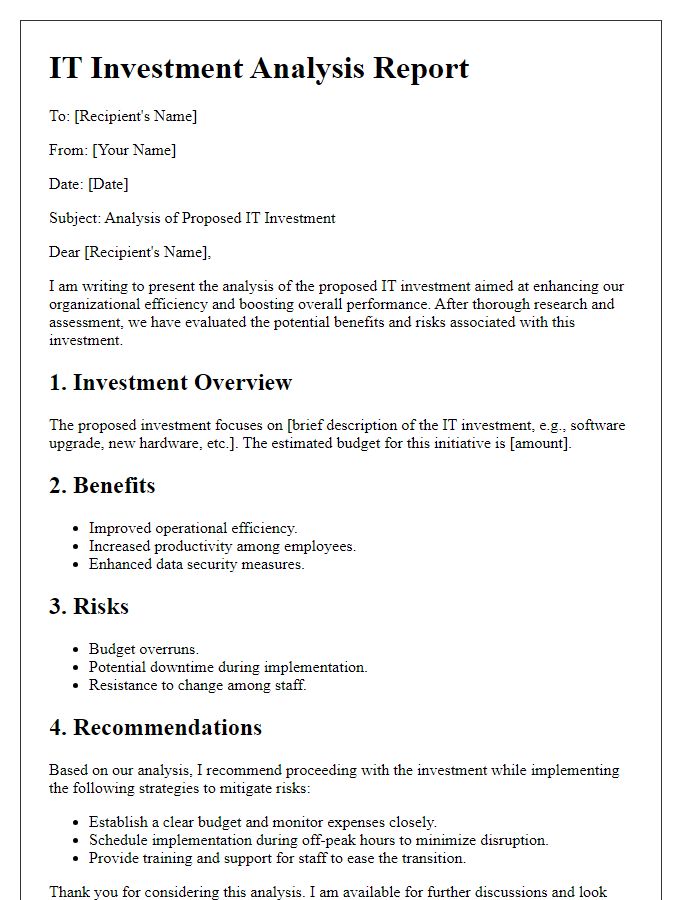Are you curious about how to effectively analyze costs related to IT infrastructure? Understanding the intricacies of these expenses can significantly impact your organization's budget and planning decisions. In this article, we will dive into key strategies for assessing IT infrastructure costs, offering practical tools and insights to streamline your analysis. So, let's explore how you can optimize your IT investmentsâread on to discover more!

Identifying objectives and scope of analysis
Objectives of IT infrastructure cost analysis focus on understanding total costs associated with systems, services, and support elements required for effective operation in organizations. Critical scope includes assessing hardware expenditures for servers and networking equipment, software licensing fees for essential applications, and maintenance costs for continuous operation. Analyzing human resources involves examining personnel costs related to IT support staff and system administrators. Evaluating cloud services such as Amazon Web Services and Microsoft Azure contributes valuable insights into subscription-based expenses. Additionally, energy consumption metrics from data centers are essential for determining operational costs and overall financial impact on the organization.
Detailed inventory of current infrastructure assets
A comprehensive inventory of current IT infrastructure assets is critical for effective cost analysis and strategic planning. This inventory typically includes servers, such as Dell PowerEdge R740, used for application hosting; network devices, including Cisco Catalyst 9300 series switches, essential for managing data flow; and storage solutions, like NetApp FAS series systems, which support data backup and recovery. Additionally, virtual machines hosted on VMware ESXi provide valuable insights into resource allocation. Documentation of software licenses, such as Microsoft Windows Server and SQL Server, alongside their respective renewal dates, helps avoid unexpected costs. Including asset age and depreciation rates enables accurate forecasting of replacement expenses. Compliance with industry standards requires regular audits to identify obsolete equipment, ultimately guiding future investments and budget planning.
Cost breakdown: acquisition, maintenance, and operational expenses
Effective IT infrastructure cost analysis requires a thorough breakdown of expenditures. Acquisition costs include hardware purchases (servers, networking equipment), software licenses (operating systems, applications), and initial setup expenses (installation, configuration). Maintenance costs encompass ongoing support (technical assistance, updates), hardware repairs (replacement parts, labor), and software maintenance (subscription renewals). Operational expenses comprise utility costs (electricity, cooling systems), staff salaries (network administrators, IT support), and training programs (educational workshops, certification courses) to ensure optimal performance. Understanding these elements helps organizations effectively allocate budgets, forecast future expenses, and make informed decisions regarding IT investments.
Analysis of infrastructure performance and utilization
Comprehensive infrastructure performance and utilization analysis identifies critical metrics essential for optimizing IT resource allocation. Key components include server usage rates, typically measured by CPU and memory consumption, along with storage performance metrics such as Input/Output Operations Per Second (IOPS) and latency levels in milliseconds. Networking infrastructure evaluation focuses on bandwidth utilization, often exceeding 80% during peak hours, indicating potential bottlenecks. Monitoring software tools provide real-time insights, with historical data trends spanning several months, enabling informed decision-making. Additionally, assessing energy consumption, often quantified in kilowatt-hours, can reveal opportunities for cost reduction through efficient hardware improvements. This holistic overview not only facilitates budget forecasting but also underscores how IT investments align with organizational growth strategies.
Recommendations and potential cost-saving measures
A comprehensive IT infrastructure cost analysis reveals various opportunities for savings across several components. Server maintenance (averaging $1,500 per month) presents a significant area for potential reductions; transitioning to cloud services like Amazon Web Services (AWS) can minimize physical hardware expenses and enhance scalability. Software licensing costs, particularly for enterprise solutions such as Microsoft 365, may be optimized through subscription plan reviews, ensuring alignment with actual usage across approximately 200 employees. Network expenses, influenced by outdated systems and bandwidth requirements, can benefit from upgrades to fiber optics, which can reduce monthly costs by 20%. Regularly evaluating vendor contracts and service agreements can also uncover hidden fees or better pricing, leading to savings of up to 15% annually. Implementing automation tools for routine IT tasks can decrease labor hours, achieving an average savings of $30,000 per year. Strategic investments in energy-efficient hardware can further contribute to a reduction in utility bills, with potential savings of 10% on energy costs.













Comments